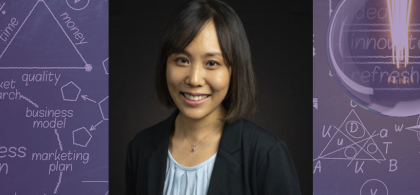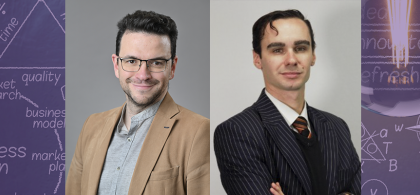
How to handle genuine dilemmas: Theory of the paradox
Health or the economy? The recent crisis has shown how extremely complex it is to make a radical decision. Especially since the two elements are intertwined. This question is at the heart of the paradox theory. Patrick Lê, assistant professor in the People and Organizations Department at NEOMA, imagines solutions.
How do you handle a genuine dilemma? How do you urgently address a health crisis while respecting scientific rigour? How does a socially committed company generate profit? How do you find balance between the exploration of new, innovative goods and services and the profitability created by operating existing markets? These are the types of questions that fall within the realm of the theory of the paradox.
“The theory of the paradox is centred on the constant opposition between two poles that are contradictory, yet interdependent and complementary and above all necessary,” Patrick Lê, assistant professor at the NEOMA People and Organisations Department, said. “Neither one or the other can given more importance, nor can one be sacrificed for the other. Both are needed.”
The NEOMA professor contributed to a research project on the subject and published a co-authored article titled A Paradox Approach to Societal Tensions during The Pandemics Crisis in the Journal of Management Inquiry in February 2021. It was the authors’ aim to underscore that this tension can never be resolved. There cannot be an ultimate solution, only provisional solutions. The weakest, least appreciated component needs protection and a minimum defensive threshold should be established. And creativity should be employed as the response. “The two poles should not be viewed as opposing elements, but rather as offering synergetic possibilities,” Patrick Lê said. “Like in music, there is are intentional dissonant notes, but taken together, they form a harmony.”
Here are a few examples.
THE PARADOX: RIGOUR /EXPEDIENCY
Kid holding globe map sphere isolated on black horizontal background. Ecological problems disasters. COVID-19 pandemic infection disease concept image, copy space for text
The tension between rigour and expediency: The Covid-19 virus surged in the spring of 2020. The scientists have been standing ready to respond to the concerns arising from it. “At the beginning of the Covid-19 pandemic, a lot of low-quality articles came out in the specialist reviews,” the NEOMA professor said. It’s what is called “paperdemic” or “speedscience.” The studies were not conducted with sufficient rigour nor followed strict protocol. Of course there was the urgent need to care for the general population and to find a solution to the pandemic. But expediency got the most attention to the detriment of rigour. But serious scientific research needs a lot of trials on cohorts of individuals and a lot of analyses and replicated studies. Only through this process can rigorous results be obtained. And that can take several years. Even worse, there is no limit for achieving absolute rigour.
The solution: a threshold for rigour, for example, should have been established, where it is not permitted to drop below this threshold or use studies that have been performed too quickly. Or we could create a rewards system for high-quality publications to help the general public ranks them in importance.
THE PARADOX: SOCIAL / BUSINESS
The tension between social engagement and business: In Cambodia, a company offers jobs to a rural, disadvantaged population. The company trains the people for IT jobs. Why IT? Because the sector does not require too much investment and sales are soaring. At the same time the company has to generate revenue. Without any revenue, there will be no jobs. On one side, the company assists a rural population, and on the other, there is the need for offices and infrastructure, which are more often found in urban areas. Where should the company’s headquarters be located? On one side, the company employs people to help them acquire skills, and on the other, it needs a base skill level to operate. “If a purely economic aim is the central focus, then the classic model of a company seeking profit and helping no one rises up, “ Patrick Lê said. “And conversely, if the company sets up in the countryside, it will go bankrupt. How can a sustainable model be created?”
The solution: “Tensions between economics and social commitment can never be resolved. They must alternately be given priority,” The professor said. This company has moved too close to one side and gone too far from the other. It realised this before it was too late and set up a checks and balances system. They integrated staunch businessmen as well as NGO stakeholders and they also set up both economic and social impact performance indicators. If the balance leans too far to one side, each actor can raise the alarm and correct the trend.
THE PARADOX: EXPLORATION / EXPLOITATION
Exploration and exploitation in balance – pictured as balanced balls on scale that symbolize harmony and equity between Exploration and exploitation that is good and beneficial., 3d illustration
The tension between operation and exploration. One the one hand, a business must always be up to date and innovate. It needs to offer new features, whether they are products or services. On the other hand, the business must also turn a profit from the time spent on research and development. It must start mass production to create economies of scale and generate profits. “It is nearly impossible to have both at the same time,” Patrick Lê said. “They are two fundamentally opposing poles and you can be tempted to rest on just one or the other.” The professor used examples of hotels that did not see the Air BnB trend coming. “They invested in their infrastructure and they wanted to do greater volume, but they did not pay attention to the small signs that announced a change in lodging habits.”
The solution: “The solution can be organisational in nature,” the NEOMA professor said. The R&D teams want to do what they enjoy doing, meaning innovate. Conversely, the operators can only see the profits of a product and do not see the need for exploration. Perhaps the two poles need to be separated, alternating over time from one to the other. “This means alternating from innovation phases to phases using these innovations, then reinvesting the generated revenue in further innovation,” Patrick Lê said. This can be done by creating two departments and ensuring a balance of power between them. Generally speaking, a balance must be maintained in any condition. For example, even if the situation seems to favour operation and an existing service works well for example, the company should not rest on its laurels and should do its best to turn their attention to the other pole, exploration and possible innovations.
Read the article
Sharma, G., Bartunek, J., Buzzanell, P. M., Carmine, S., Endres, C., Etter, M., Fairhurst, G., Hahn, T., Lê, P., Li, X., Pamphile, V., Pradies, C., Putnam, L. L., Rocheville, K., Schad, J., Sheep, M., & Keller, J. (2021). A Paradox Approach to Societal Tensions during the Pandemic Crisis. Journal of Management Inquiry, 30(2), 121–137. https://doi.org/10.1177/1056492620986604



